人教版英语必修一Unit 3(Reading)教学教案
- 格式:docx
- 大小:15.07 KB
- 文档页数:4
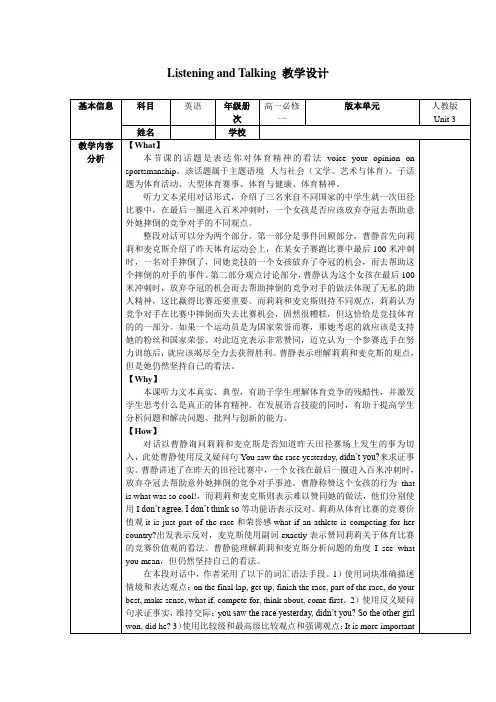
Listening and Talking 教学设计基本信息科目英语年级册次高一必修一版本单元人教版Unit 3姓名学校教学内容分析【What】本节课的话题是表达你对体育精神的看法voice your opinion on sportsmanship。
该话题属于主题语境--人与社会(文学、艺术与体育)。
子话题为体育活动、大型体育赛事、体育与健康、体育精神。
听力文本采用对话形式,介绍了三名来自不同国家的中学生就一次田径比赛中,在最后一圈进入百米冲刺时,一个女孩是否应该放弃夺冠去帮助意外她摔倒的竞争对手的不同观点。
整段对话可以分为两个部分。
第一部分是事件回顾部分,曹静首先向莉莉和麦克斯介绍了昨天体育运动会上,在某女子赛跑比赛中最后100米冲刺时,一名对手摔倒了,同她竞技的一个女孩放弃了夺冠的机会,而去帮助这个摔倒的对手的事件。
第二部分观点讨论部分,曹静认为这个女孩在最后100米冲刺时,放弃夺冠的机会而去帮助摔倒的竞争对手的做法体现了无私的助人精神,这比赢得比赛还要重要。
而莉莉和麦克斯则持不同观点,莉莉认为竞争对手在比赛中摔倒而失去比赛机会,固然很糟糕,但这恰恰是竞技体育的的一部分。
如果一个运动员是为国家荣誉而赛,那她考虑的就应该是支持她的粉丝和国家荣誉。
对此迈克表示非常赞同,迈克认为一个参赛选手在努力训练后,就应该竭尽全力去获得胜利。
曹静表示理解莉莉和麦克斯的观点,但是她仍然坚持自己的看法。
【Why】本课听力文本真实、典型,有助于学生理解体育竞争的残酷性,并激发学生思考什么是真正的体育精神。
在发展语言技能的同时,有助于提高学生分析问题和解决问题、批判与创新的能力。
【How】对话以曹静询问莉莉和麦克斯是否知道昨天田径赛场上发生的事为切入,此处曹静使用反义疑问句You saw the race yesterday, d idn’t you?来求证事实。
曹静讲述了在昨天的田径比赛中,一个女孩在最后一圈进入百米冲刺时,放弃夺冠去帮助意外她摔倒的竞争对手事迹。
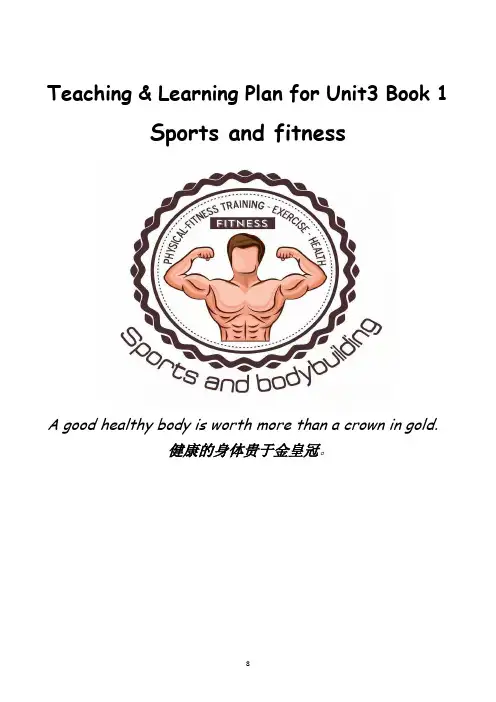
Teaching & Learning Plan for Unit3 Book 1Sports and fitnessA good healthy body is worth more than a crown in gold.健康的身体贵于金皇冠。
Unit3 单元核心素养---教学目标与要求Teaching & Learning Plan for Period I, Unit3, Book 1Warming up & ReadingType: New TeachingPart One: Key competences(核心素养)Language abilities (语言能力) Understanding the general meaning of the new text Learning abilities (学习能力) Train the reading ability to scan for the detailed information Cultural awareness(文化意识)Learn about sports and games around the world. Thinking qualities(思维品质) Talk about sports events and sportsmanship.Part Two: Independent Learning【自主学习·预习初探】【Pre-reading activity.读前活动】I. Words:(tip:不要简单地抄写,而是尽量默写出下列单词)1.健康;健壮;适合n. ___________2.体育场;运动n.________3.比赛项目;大事;公开活动n. _________4.滑雪的adj.;滑雪v.______5.vt.主办;主持n.主人;主办人;主持人____6.跑道;足迹;铁轨n. _______7.健身房;体育馆n. ___________ 8.体操(训练) n. _________9.流汗vt./vi.汗水;出汗n._________ 10.传奇故事/人物;传说n._______11.运动员;运动健n. __________ 12.高手;主人n.精通;掌握vt._____13.荣誉;尊敬;荣幸n. ___________ 14.荣誉;光荣;赞美n. _________15.奖章;勋章n. ____________ 16.冠军;优胜者n. __________17.锦标赛;冠军赛;冠军称号n. ____ 18.决心;决定n. __________19. 分离;分开;成碎片adv.________ 20.使受伤;损vt. __________21.受伤的;有伤的adj. ___________ 22.伤害;损伤n. __________23. 队长;船长;机长n. ___________ 24.优美的;优雅的adj._________25.力量;体力n. ___________ 26.失败;失败的人/事物n._____27.竞争;对抗vi. ___________ 28.假装;装扮v. _________29.一百万num. ___________ 30.作弊;vi.欺骗n.骗子________31.观众;听众n. ___________ 32.积极的;肯定的adj._________33.苗条的;单薄的adj. ___________ 34.日常饮食n.节食v._________35.相当;有点儿adv. ___________ 36.慢跑n./v. _________37.错误;差错n.________38.压力;重音n.强调;重读;使焦虑不安v.____1996年至今一直在帮助年轻人。
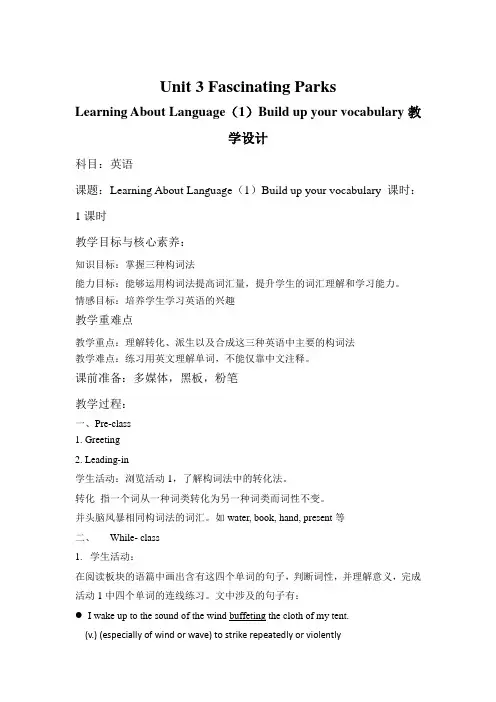
Unit 3 Fascinating ParksLearning About Language(1)Build up your vocabulary教学设计科目:英语课题:Learning About Language(1)Build up your vocabulary 课时:1课时教学目标与核心素养:知识目标:掌握三种构词法能力目标:能够运用构词法提高词汇量,提升学生的词汇理解和学习能力。
情感目标:培养学生学习英语的兴趣教学重难点教学重点:理解转化、派生以及合成这三种英语中主要的构词法教学难点:练习用英文理解单词,不能仅靠中文注释。
课前准备:多媒体,黑板,粉笔教学过程:一、Pre-class1. Greeting2. Leading-in学生活动:浏览活动1,了解构词法中的转化法。
转化指一个词从一种词类转化为另一种词类而词性不变。
并头脑风暴相同构词法的词汇。
如water, book, hand, present等二、While- class1.学生活动:在阅读板块的语篇中画出含有这四个单词的句子,判断词性,并理解意义,完成活动1中四个单词的连线练习。
文中涉及的句子有:I wake up to the sound of the wind buffeting the cloth of my tent.(v.) (especially of wind or wave) to strike repeatedly or violently●I leave my tent and walk over to the mountain edge.(n.) the outer limit of an object●I'm in the remote far north of Sweden in Sarek National Park, a place with noroads or towns.(adj.) far from, not close●Though the Sami are allowed to continue their traditional way of life in the park,no one else canlive here, and all new development is banned within park boundaries.(v.) to officially or legally prohibit活动目的:本活动的目的是在语境中复现词汇,强化学生对“语言知识的表意功能”的认识。
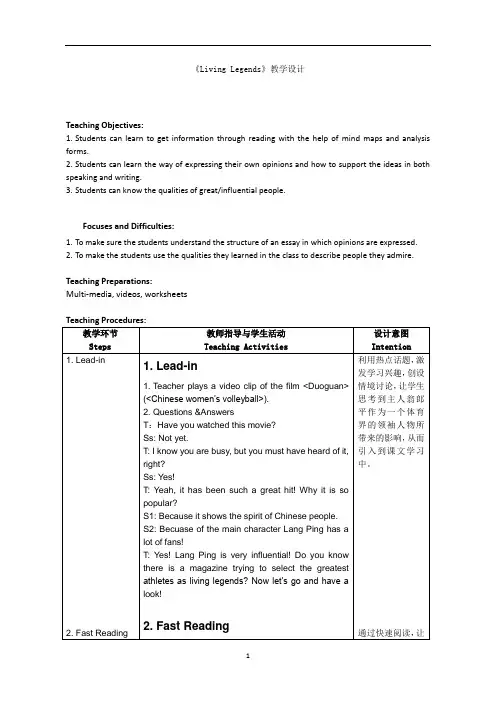
《Living Legends》教学设计Teaching Objectives:1.Students can learn to get information through reading with the help of mind maps and analysis forms.2.Students can learn the way of expressing their own opinions and how to support the ideas in both speaking and writing.3.Students can know the qualities of great/influential people.Focuses and Difficulties:1.To make sure the students understand the structure of an essay in which opinions are expressed.2.To make the students use the qualities they learned in the class to describe people they admire.Teaching Preparations:Multi-media, videos, worksheets教学环节Steps教师指导与学生活动Teaching Activities设计意图Intention1. Lead-in2. Fast Reading 1. Lead-in1. Teacher plays a video clip of the film <Duoguan>(<Chinese women’s volleyball>).2. Questions &AnswersT:Have you watched this movie?Ss: Not yet.T: I know you are busy, but you must have heard of it,right?Ss: Yes!T: Yeah, it has been such a great hit! Why it is sopopular?S1: Because it shows the spirit of Chinese people.S2: Becuase of the main character Lang Ping has alot of fans!T: Yes! Lang Ping is very influential! Do you knowthere is a magazine trying to select the greatestathletes as living legends? Now let’s go and have alook!2. Fast Reading利用热点话题,激发学习兴趣,创设情境讨论,让学生思考到主人翁郎平作为一个体育界的领袖人物所带来的影响,从而引入到课文学习中。
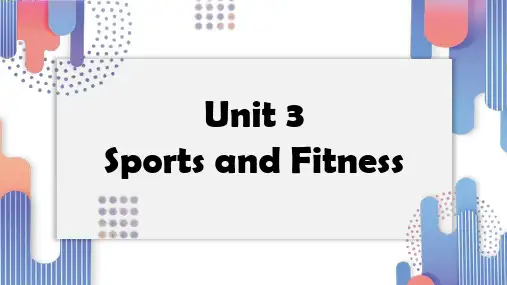
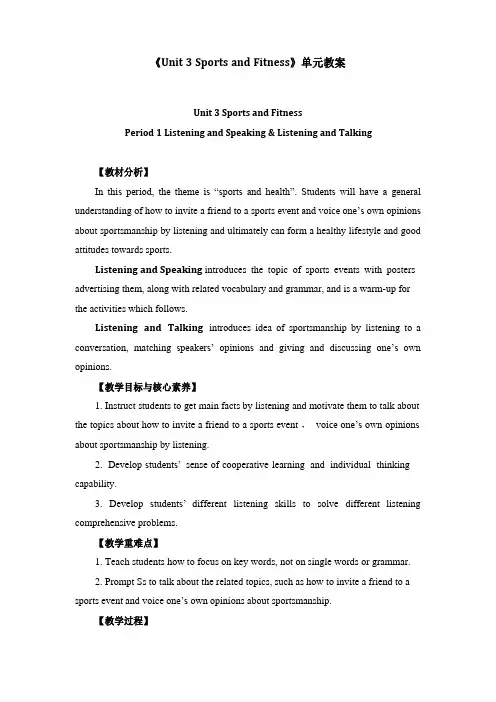
《Unit 3 Sports and Fitness》单元教案Unit 3 Sports and FitnessPeriod 1 Listening and Speaking & Listening and Talking【教材分析】In this period, the theme is “sports and health”. Students will have a general understanding of how to invite a friend to a sports event and voice one’s own opinions about sportsmanship by listening and ultimately can form a healthy lifestyle and good attitudes towards sports.Listening and Speaking introduces the topic of sports events with posters advertising them, along with related vocabulary and grammar, and is a warm-up for the activities which follows.Listening and Talking introduces idea of sportsmanship by listening to a conversation, matching speakers’ opinions and giving and discussing one’s own opinions.【教学目标与核心素养】1.Instruct students to get main facts by listening and motivate them to talk about the topics about how to invite a friend to a sports event ,voice one’s own opinions about sportsmanship by listening.2.Develop students’sense of cooperative learning and individual thinking capability.3.Develop students’different listening skills to solve different listening comprehensive problems.【教学重难点】1.Teach students how to focus on key words, not on single words or grammar.2.Prompt Ss to talk about the related topics, such as how to invite a friend to a sports event and voice one’s own opinions about sportsmanship.【教学过程】Part 1: Listening and SpeakingLead inThe teacher is advised to talk with their students about sports events.Boys and girls, look at the posters on p36, what sports events do you like to watch? Which sports would you like to try? After their small talk, the teacher can move on by finishing the following listening task:Play conversation 1 which is about Shen Qi’s main purpose for talking to Amy and after finishing listening for the first time, the students need to solve the following tasks.1.Purpose2.Listen to conversation 1 again and write down the words that the speaker stresses:Listening tip:Listen for main ideas.Try to catch the main ideas instead of trying to remember and translate each word you hear.After finishing the task above, the teacher is expected to play conversation 2 which is about Adam’s inviting Julie to a sports event and after finishing listening, the students need to solve the following task.Listen to Conversation 2. Then answer the following questions:1.When will the event happen?The event will happen2.What”s a “Blue Paint“ run?A “Blue Paint“ run is a fun run that3.Why is it called a “Blue Paint“ run?Because people can buy water ballons flled with and the runners.4.If 200 people take part in the run and 400 balloons are sold, how much money will they collect?Finally, after finishing the task above, the teacher is expected to instruct students to work in groups to finish the following project:Speaking ProjectWhat event or activity would you like to invite your friend to? Make a conversation with a partner.Ski Race: Zhangjiakou, a beautiful city in northern China, will host the Youth Ski Race in December.Track Meet: a great event for track –and –field lovers on 26 October.Gym Class: come and work out at a gym! You can make it.Part 2: Listening and Talking:The teacher is advised to talk with their new students about the related topic:Boys and girls , what do you think of sportsmanship? Let’s listen and find out: Play the listening and match each opinion with the right speaker. Who do you agree with? Why?Cao Jing Lily MaxA.An athlete should do his/her best to win.B.The girl should stop and help the other girl. Good sportsmanship is more important than wining!C.An athlete should think about honor and his/her fans if he/she is competing for his/her country.Listen again and circle the expressions that you hear in the conversation.agreeingI agree.So do I. Exactly!All right Good idea. Yes, I think so. disagreeingI”m sorry, but I disagree/don”t agree. I don”t think so. That”s not right.That doesn”t make any sense! That”s not how I see it.I see what you mean, but …Me too.Sure./Certainly./Of course. You”re right/correct.I guess so.Talking projectWork in groups. Choose one of the situations below and make a conversation:●A soccer player should not pretend to fall down even if it helps his/her team.●In school teams, everyone should get a chance to play, not only the best players.●It is wrong to pay people millions of yuan to play sports.●Athletes should play only for their own country.EXAMPLEA: I agree with the idea that a soccer player should never pretend to fall down even if it helps his or her team. You should never cheat.B: Exactly! It”s important to do the right thing.C: Well, don”t think so. Many players do it, and they think it helps their team to win. A: That doesn”t make any sense!B: I see what you mean, but the audience wants fair play.Unit 3 Sports and Fitness-Listening and Speaking & Listening and Talking【教材分析】This lesson focuses on the discourse analysis of its organization and features. Through the questions, the students are guided to sort out why Lang Ping and Jordan are masters and what role models they set. On this basis, the students are allowed to use the language they have learned to talk about the sports stars in their minds.【教学目标与核心素养】1.Read quickly to get basic information about Lang Ping and Jordan; read deeply to understand why they can be called sports legends.2.Understand the meaning of some languages in the context of the text through question guidance, such as “time seems to stand still, graceful“ and so on.3.Read and clarify the context of each part of the text, learning how to talk a write sports legends.4.Through comparativeanalysis,w e can form the criterif aor judgingthelegendary figures and learn to choose the legendary sports stars we like.【教学重难点】1.Get basic information about Lang Ping and Jordan; read deeply2.Understand why they can be called sports legends.3.Understand the meaning of some languages in the context of the text, such as “time seems to stand still, graceful“ and so on.【教学过程】Step 1 Leading-in1.Have the Ss ask and answer in pairs.Q1: Who are your favorite sports player?Q2: Do you like him/her? Why?2.Then ask the Ss to talk about Lang Ping and Michael Jordan, and have several Ss to share their ideas.Q1: What do you know about Lang Ping and Michael Jordan?Q2: What else do you want to know about them?Step 2Understanding the title and the lead paragraph.Have the Ss think about the title and answer the following questions.Q1: Why do you think the author chooses to write these two sports stars?Q2: What does “living legend” mean?Q3: What are the standards or requirements to be chosen as a living legend of sports star?Then discussthe questionsabove in groups,then have someone to sharetheir ideas.Step 3 Getting detailed information about Lang Ping1.Read to answer the following questions.Living legends Jordan Masters?Good examples?Q1: Is Lang Ping a master in her area? How do you know that?Q2: What good examples does Lang Ping set for others?2.Read again and Focus on the story about Lang Ping. Then try to retell the story of Lang Ping.Step 4 Exploring detailed information about Michael Jordan1.Read the paragraph of Michael Jordan and complete the following table.We have got to know why Lang Ping is a living legend. Now read and find out why Michael Jordan is a living legend on your own by completing the following table.2.Sort out detailed information about Michael Jordan.(1)Understand the transitional sentence.Q: Which part is about Michael Jordan as a master? Which part is about the example he set?(2)Have the Ss Focus on why Michael Jordan is a master and what good examples Michael Jordan set when they’re reading. And think about these questions as below:Q1: How does the author describe his impressive skills?Q2: How do you understand “time seemed to stand still”?Q3: What does “graceful” mean?Q4. Which sentence do you think best describes his mental strength?Q5. Which words is important in the sentence in describing his mental strength? Why?Q6: How do you understand “unique”?Q7: What can we learn from Michael Jordan?Step 5 Discussing and recommendingRecommend their own living legends of sports.Work in groups to choose your own living legend of sports and give the reasons of your choice.Step 6 HomeworkReview the stories of Lang Ping and Michael Jordan, and try to retell them.Unit 3 Sports and FitnessPeriod 3 Discovering Useful Structures—tag questions【教材分析】This teaching period mainly deals with the grammar: tag questions.This period carries a considerable significance to the cultivation of students’spoken English. The teacher is expected to enable students to master this period thoroughly and consolidate the knowledge by doing some exercise of good quality. 【教学目标与核心素养】1.Get students to have a good understanding of the basic usages of tag questions.2.Enable students to use the basic phrases structures flexibly.3.Develop students’ speaking and cooperating abilities.4.Strengthen students’ great interest in grammar learning.【教学重难点】1.How to enable students to have a good understanding of the basic usages of tag questions.2.How to enable students to use the basic usages of tag questions flexibly.【教学过程】Step1: 语法自主探究一、根本组成方法1. 确定式陈述You often play badminton, don’t you?你常常打羽毛球,是吗?局部+否认附加You are going to the gym with me, aren’t you?疑问局部〔前肯你要和我一起去健身房,是吗?她以前去过上海,是后否〕She’s been to shanghai before, hasn’t she?吗?2.否认式陈述It isn”t a beautiful flower, is it?那不是秀丽的花,是吗?局部+确定附加You didn”t go skating yesterday, did you? 你昨天没去滑冰,是疑问局部〔前否吗?后肯〕They can’t finish it by Friday, can they?他们不能在星期五之前完成,是吗?3.含有否认词〔1 〕当陈述句中含有He hardly goes to school by car, 的附加疑问句seldom, hardly, never, does he?rarely, little, few, none, 他几乎不开车去上学,是吗?neither ,no, not, nowhere, You have never been to Paris, havenothing no one, nobody 等you?否认意义的词时,后面的你从没去过巴黎,是吗?附加疑问句则为确定形They seldom come late, do they?式。
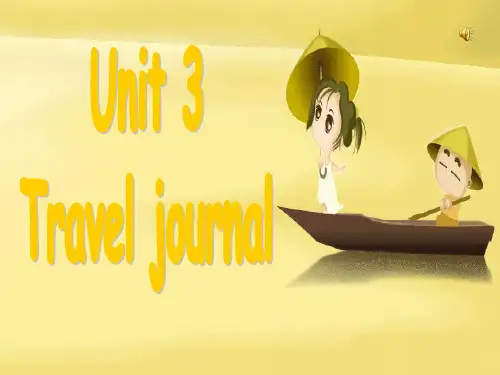
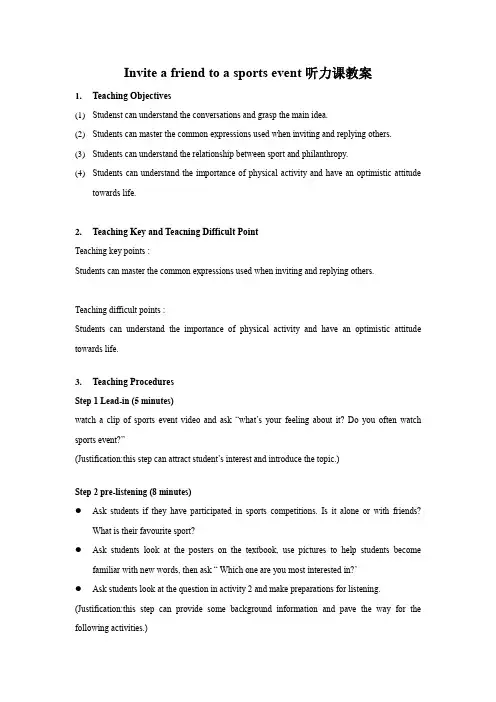
Invite a friend to a sports event听力课教案1.Teaching Objectives(1)Studenst can understand the conversations and grasp the main idea.(2)Students can master the common expressions used when inviting and replying others.(3)Students can understand the relationship between sport and philanthropy.(4)Students can understand the importance of physical activity and have an optimistic attitudetowards life.2.Teaching Key and Teacning Difficult PointTeaching key points :Students can master the common expressions used when inviting and replying others.Teaching difficult points :Students can understand the importance of physical activity and have an optimistic attitude towards life.3.Teaching ProceduresStep 1 Lead-in (5 minutes)watch a clip of sports event video and ask “what’s your feeling about it? Do you often watch sports event?”(Justification:this step can attract student’s interest and introduce the topic.)Step 2 pre-listening (8 minutes)●Ask students if they have participated in sports competitions. Is it alone or with friends?What is their favourite sport?●Ask students look at the posters on the textbook, use pictures to help students becomefamiliar with new words, then ask “ Which one are you most interested in?’●Ask students look at the question in activity 2 and make preparations for listening. (Justification:this step can provide some background information and pave the way for the following activities.)Step 3 while-listening (20 minutes)1)Ask students to listen conversation 1 and find out Shen Qi’s main purpose for talking to Amy.Then check the answer together.2)Summarize some tips to grasp main idea.3)Ask students to listen conversation 1 again and finish activity 3.Then check the answertogether.4)Ask students to listen conversation 2 and finish the questions in activity 4.Then check theanswer together.5)Ask students think about the purpose of “BluePaint” run, and ask do you think this activity isworthwhile? Why? If you were given a chance, would you go for it?(Justification: This step can help students understand the listening material and improve their listening abilities to grasp main idea and detailed information.)Step 4 post-listening(10 minutes)Pair work●Summarize the expression used to invite othersWould you like to.....That would be great.How/What about....All right!Why don’t you....Yes, I’d love to.Could you please.....I’m sorry./I’m afraid I can’tI’d like to invite you to.....I’d like to, but......●Look at the three sports event in activity 5, which one would you like to invite your friends to?Make a conversation used what we have learnt today.(Justification: This step can help students consolidate what they have learned and help students to apply the new knowledge to other situation.)4.Homework (2 minutes)Invite your friends to watch sports with you.。
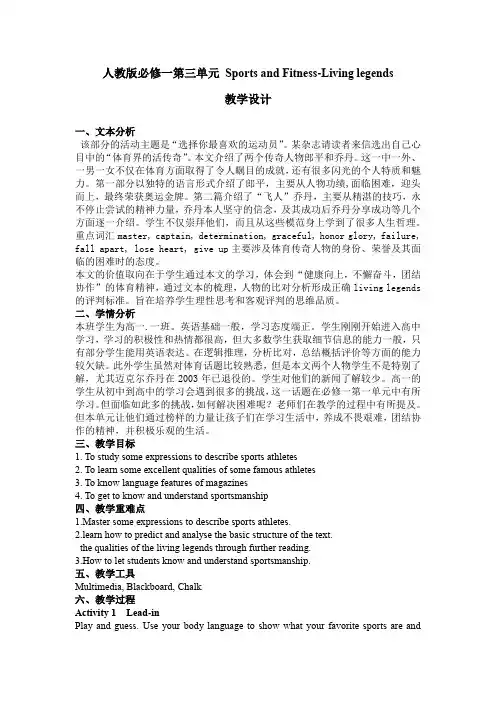
人教版必修一第三单元Sports and Fitness-Living legends教学设计一、文本分析该部分的活动主题是“选择你最喜欢的运动员”。
某杂志请读者来信选出自己心目中的“体育界的活传奇”。
本文介绍了两个传奇人物郎平和乔丹。
这一中一外、一男一女不仅在体育方面取得了令人瞩目的成就,还有很多闪光的个人特质和魅力。
第一部分以独特的语言形式介绍了郎平,主要从人物功绩,面临困难,迎头而上,最终荣获奥运金牌。
第二篇介绍了“飞人”乔丹,主要从精湛的技巧,永不停止尝试的精神力量,乔丹本人坚守的信念,及其成功后乔丹分享成功等几个方面逐一介绍。
学生不仅崇拜他们,而且从这些模范身上学到了很多人生哲理。
重点词汇master, captain, determination, graceful, honor glory, failure, fall apart, lose heart, give up主要涉及体育传奇人物的身份、荣誉及其面临的困难时的态度。
本文的价值取向在于学生通过本文的学习,体会到“健康向上,不懈奋斗,团结协作”的体育精神,通过文本的梳理,人物的比对分析形成正确living legends 的评判标准。
旨在培养学生理性思考和客观评判的思维品质。
二、学情分析本班学生为高一.一班。
英语基础一般,学习态度端正。
学生刚刚开始进入高中学习,学习的积极性和热情都很高,但大多数学生获取细节信息的能力一般,只有部分学生能用英语表达。
在逻辑推理,分析比对,总结概括评价等方面的能力较欠缺。
此外学生虽然对体育话题比较熟悉,但是本文两个人物学生不是特别了解,尤其迈克尔乔丹在2003年已退役的。
学生对他们的新闻了解较少。
高一的学生从初中到高中的学习会遇到很多的挑战,这一话题在必修一第一单元中有所学习。
但面临如此多的挑战,如何解决困难呢?老师们在教学的过程中有所提及。
但本单元让他们通过榜样的力量让孩子们在学习生活中,养成不畏艰难,团结协作的精神,并积极乐观的生活。
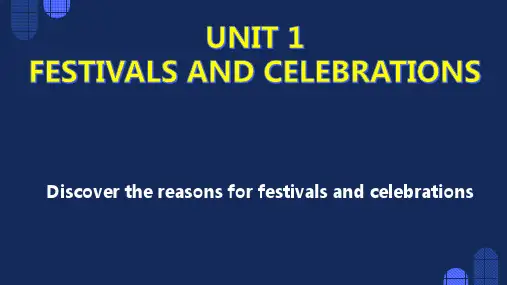
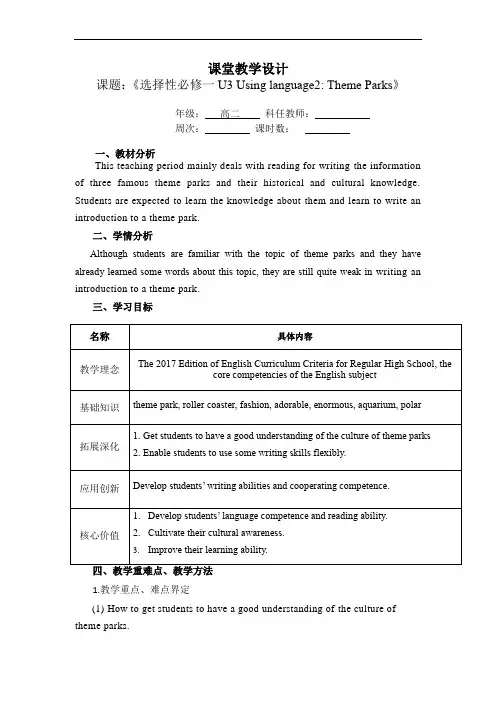
课堂教学设计课题:《选择性必修一U3 Using language2: Theme Parks》年级:高二科任教师:周次:课时数:一、教材分析This teaching period mainly deals with reading for writing the information of three famous theme parks and their historical and cultural knowledge. Students are expected to learn the knowledge about them and learn to write an introduction to a theme park.二、学情分析Although students are familiar with the topic of theme parks and they have already learned some words about this topic, they are still quite weak in writing an introduction to a theme park.三、学习目标名称具体内容教学理念The 2017 Edition of English Curriculum Criteria for Regular High School, the core competencies of the English subject基础知识theme park, roller coaster, fashion, adorable, enormous, aquarium, polar拓展深化1. Get students to have a good understanding of the culture of theme parks2. Enable students to use some writing skills flexibly.应用创新Develop students’ writing abilities and cooperating competence.核心价值1.Develop students’ language competence and reading ability.2.Cultivate their cultural awareness.3.Improve their learning ability.1.教学重点、难点界定(1) How to get students to have a good understanding of the culture of theme parks.(2) How to enable students to use some writing skills flexibly.2.突破方法有效1. Develop students’ writing and cooperating abilities.2. Strengthen students’ great interest in writing discourses.五、教学过程1.导入新课Step 1: Match the words and expressions with the descriptions.2.落实基础Step 2:(1)Discuss what is a theme park and different themes based on those parks.(2) Read for the text structure and find out the topic sentence of each paragraph.(3) Fill in the table below when you finish reading.3.拓展深化Step 3:(1) The table on page 32 shows the introductions to each theme park. Whatheaders would you give for columns A to D?A Name and locationB _____________________C _____________________D _____________________(2) Figure out whether the statements are true according to the passage.(3) Choose the best answer.Step 4: How to write an introduction to a park?(1)Provide the outline;(2)Make a mind map;(3)Use some useful expressions to write a draft.5.课堂检测Finish the exercises on p32 & p33.6.小结与课后作业布置(1)课堂小结Have students learn the information of three famous theme parks and their historical and cultural knowledge and master some writing skills.(2)课后作业巩固型:Write down your own passage.复习型:Review the new words.六、课堂反思(课后填写)。
UNIT3FASCINATING PARKS主题语境人与自然——主题公园背景导入:本篇就香港海洋公园在位置,历史,构成及其特色方面给读者提供了一个简要介绍。
Hong Kong Ocean ParkOcean Park,which is situated①on the southern side of Hong Kong Island,is one of the largest marine parks in the world covering more than870,000square metres.With about40years of history,Ocean Park has become one of the major tourist attractions②in Asia.Aside from entertaining③visitors with thrill rides and a wide variety of④shows,the park prides itself on its education and conservation programmes.Ocean Park consists of⑤two sections,the Headland and the Lowland,which are connected by a1.5km long cable car(缆车)system which offers wonderful views of the southern side of Hong Kong and the South China Sea.The Headland is known for its many thrill rides including⑥the Dragon,Eagle,Crazy Galleon,Ferris Wheel,Ocean Park Tower,Flying Swing,Raging River, Space Wheel,and Mine Train.The Headland also contains the Ocean Theatre,where dolphins and sea lions entertain visitors each day with their lively performances.Providing more enjoyment and education are the world-class Atoll Reef Aquarium(水族馆),the Shark Aquarium and the Pacific Pier.At the Lowland,visitors can take a ride⑦on a giant hot air balloon that is22metres in diameter which takes them high into the air.Visitors can also see the giant pandas given by the Central Government of China at the Hong Kong Jockey Club Giant Panda Habitat.Other attractions include Amazing Amazon,Amazing Birds Theatre and Kid's World.Located⑧beside Kid's World is Dolphin University where visitors are able to have a closer look at dolphins andlearn more about them.①situate v t.使位于;使坐落于②tourist attraction旅游景点③entertain v t.&v i.(使)快乐;(使)娱乐④a wide variety of各种各样的⑤consist of包括;由……组成⑥including prep.包括……在内⑦take a ride乘坐⑧located adj.位于;坐落在[随手记]SectionⅠReading and Thinking每/日/金/句:There are more and more theme parks in China.And whichever and whatever you like,there is a theme park for you.中国有越来越多的主题公园。
Unit 3 Sports and FitnessPeriod 1 Listening and Speaking教材分析开篇页选择了年轻人晨跑作为主题图,体现出一种奋进向上以及“生命在于运动”的积极意义,引入运动和健康学习这一单元。
现代奥运之父顾拜旦(Pierre de Coubertin)的名言“All sports for all people.”诠释了人人都有运动的权利。
听说板块围绕“邀请朋友参加体育运动(Invite a friend to a sports event)”,学生通过听两段介绍运动项目的对话,了解体育的趣味性,并通过听和说的形式,结合语境,学习提出邀请和答复邀请的语言功能项目。
语音板块为帮助学生复习并掌握附加疑问句中升调和降调的基本知识。
教学目标1. 能正确理解使用下列词汇:soccer,stadium,boxing,marathon,event,ski。
2. 能在听力活动中抓住内容的主旨大意。
3. 通过阅读开篇页信息,熟悉单元主题语境,预测单元内容,明确学习内容。
4. 能通过运用听力材料中所提取的体育及运动的信息,学会提出邀请和答复邀请。
教学重难点【教学重点】引导学生听取对话的主旨大意,掌握该板块出现的体育运动项目的名称词。
【教学难点】指导学生使用得体的语言邀请别人以及答复邀请。
教学过程Task 1Step 1 Warming-upLook at the opening page and discuss the following questions.(1) Do you jog often?(2) What kind of sports and exercise do you like?(3) What do you think sports and exercise can do for you?(4) Do you know some famous athletes at home and abroad?设计意图:引导学生讨论开篇页所呈现的信息,引出本单元话题,并对本课将要学习的运动与健康做好铺垫。
Unit3 Travel Journal Reading (Part1: Journey down the Mekong River) Analysis of the teaching material The teaching material used in this lesson is the NEW SENIOR ENGLISH FOR CHINA:STUDENT’S BOOK 1, PEP version, which is written on the base of task-based language teaching concept. Its topics are related to students’ daily life and that helps to arouse the students’ learning interest.
The topic of unit3 in the textbook is about travel, enabling the students to know something about countries or regions by traveling, such as local conditions and customs, geographical characteristics and climate features. Reading is the first part of the journal. it tells the story of Wang Kun and Wang Wei's bike travel dreams and plans, describes what they have done for the tour, such as selecting the route and looking at maps to get information about the Mekong river. The journal is written in the first person. Through the introduction to Wang Wei’s way of doing things, we have a deep impression on her characteristics.
Teaching goals 1. Knowledge goal Learn something about the Mekong River through reading. 2. Ability goal (1) To develop the students ’ability of reading, such as scanning, skimming and detailed reading.
(2) To cultivate the students’ ability of cooperation 3. Affective aims Students should realize if they want to be successful, what personalities they should have.
Teaching important and difficult points: 1. Understand the text well. 2. How to grasp the main idea of the text Teaching methods Task-based language teaching Teaching aids: a computer & a projector Teaching procedures Step Ⅰ Lead In(1minute) T: Q1: Have you visited any river? Q2: How many great rivers do you know? Q3: If you can travel down only one of them, which one would you choose? Why? Show pictures and maps of some famous rivers in China, students tell their names. (The Yellow River, the Changjiang River, the Pearl River and the Mekong River)
Step ⅡPre-reading(2 minutes) T: Have you visited the Mekong River? If no, let’s learn something about it. 1. Show a map of the Mekong River and the brief introduction of it. Ask them: Can you list the countries that the Mekong River flows through? Step ⅢReading(26minutes) In this step, get the students to read the text and finish some tasks. Fast-reading: Task1: Scan the text quickly, and then answer some questions (10minutes): Q1. What is the main idea of each paragraph? Q2.where is the source of the Mekong River and which sea does it enter? Evaluation way: oral evaluation made by students. Detailed-reading Task2:The whole read paragraph 1 loudly and find out the answer of the following questions: (4minutes)
Q1、What is Wang Kun and Wang Wei’s idea of a good trip? Q2、Who are Dao Wei and Yu Hang? Q3、Who plans the trip to the Mekong? Evaluation way: oral evaluation made by teacher. Task3:Listen to the tape of paragraph 2 carefully, and then finish the True or False questions: (4minutes) 1. Wang Wei thinks that her way is the proper way. 2. Wang Wei is a stubborn and careful girl. 3. The journey is difficult because it begins at an altitude of more than 5,000 meters, where it is hard to breathe and very cold.
Evaluation way: oral evaluation made by teacher. Task4:Role-Play. Suppose that one student is guide, the others are foreigners going to travel along the Mekong River, please the guide to introduce to the foreigners about what they can see during the journey. Read paragraph 3 carefully first. (4minutes).
Evaluation way: oral evaluation made by students. Task5: Consolidation: retell the passage and fill in the blanks (4minutes) Wang Kun and Wang Wei had ________ (dream) of taking a bike trip for a long time. After they graduated _____ college, they were ___________ (determine) to cycle along the Mekong River. In order to do the trip __________ (proper), they went to the library and found a large atlas with good _____(map) in it. After a careful study to the maps, they found the source of the river and made up ______ mind to begin their journey ____ an altitude of 5,000 meters. During their journey, they could enjoy the ________(beauty) scenery of glaciers, deep valleys, waterfalls and plains.
Evaluation way: oral evaluation made by teacher. Step IV Post-reading (10minutes) Task 6: Make comparison (5minutes) An attitude is what a person thinks about something. Make lists of Wang Wei’s and Wang Kun’s similar and different attitudes about the trip.